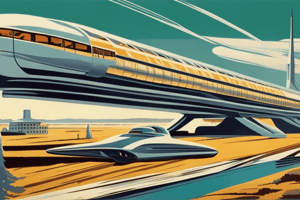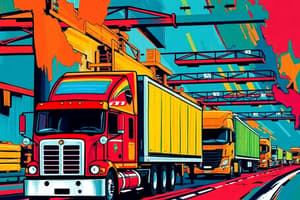Podcast
Questions and Answers
What is a primary goal of long-term transportation planning?
What is a primary goal of long-term transportation planning?
- To increase private vehicle usage
- To limit public transportation systems
- To simplify transportation networks
- To forecast future traffic demand (correct)
Which of the following is a key element of Intelligent Transportation Systems (ITS)?
Which of the following is a key element of Intelligent Transportation Systems (ITS)?
- Creating more bike lanes
- Limiting pedestrian access
- Implementing public transport limits
- Using real-time traffic monitoring (correct)
What is one significant aspect of planning pedestrian and bicycle facilities?
What is one significant aspect of planning pedestrian and bicycle facilities?
- Promoting non-motorized transportation options (correct)
- Reducing sidewalks and bike lanes
- Encouraging the use of motorized vehicles
- Focusing solely on urban traffic patterns
How do environmental considerations influence transportation project planning?
How do environmental considerations influence transportation project planning?
What role does research and innovation play in transportation planning?
What role does research and innovation play in transportation planning?
What is one significant disadvantage of rail transport?
What is one significant disadvantage of rail transport?
Which of the following is NOT a primary focus of highway engineering?
Which of the following is NOT a primary focus of highway engineering?
What is the purpose of conducting feasibility studies in planning highways?
What is the purpose of conducting feasibility studies in planning highways?
What critical aspect is considered in pavement design?
What critical aspect is considered in pavement design?
Which of the following is a key component of traffic engineering?
Which of the following is a key component of traffic engineering?
Structural engineering in highway design primarily involves which of the following?
Structural engineering in highway design primarily involves which of the following?
Why are environmental considerations important in highway engineering?
Why are environmental considerations important in highway engineering?
What is a major responsibility of construction management in highway projects?
What is a major responsibility of construction management in highway projects?
What is the primary function of transportation?
What is the primary function of transportation?
Which of the following is NOT a characteristic of road transport?
Which of the following is NOT a characteristic of road transport?
Which advantage is associated with road transport?
Which advantage is associated with road transport?
What is a significant disadvantage of road transport?
What is a significant disadvantage of road transport?
How does rail transport compare to road transport in terms of organization?
How does rail transport compare to road transport in terms of organization?
Which characteristic distinguishes rail transport during adverse weather conditions?
Which characteristic distinguishes rail transport during adverse weather conditions?
What factor influences the seasonal nature of road transport?
What factor influences the seasonal nature of road transport?
Which of the following statements is true regarding the disadvantages of road transport?
Which of the following statements is true regarding the disadvantages of road transport?
What is the primary goal of traffic flow analysis?
What is the primary goal of traffic flow analysis?
Which of the following is NOT a focus of intersection design?
Which of the following is NOT a focus of intersection design?
What is a key consideration in the development of parking management strategies?
What is a key consideration in the development of parking management strategies?
Which measure is designed specifically to slow down vehicle speeds in residential areas?
Which measure is designed specifically to slow down vehicle speeds in residential areas?
What should be a primary outcome of developing signal timing plans?
What should be a primary outcome of developing signal timing plans?
What is NOT considered an integral part of traffic management and safety?
What is NOT considered an integral part of traffic management and safety?
Which aspect of transportation planning emphasizes collaboration between sectors?
Which aspect of transportation planning emphasizes collaboration between sectors?
What is a significant area of research and innovation in traffic engineering?
What is a significant area of research and innovation in traffic engineering?
Flashcards are hidden until you start studying
Study Notes
Importance of Transportation
- Transportation encompasses movement of goods and people, ensuring time and place utility.
- Facilitates availability of products at the right time to customers.
- Essential for highway development and traffic volume estimation.
Different Modes of Transportation
- Roadways: Transporting goods and passengers; precursor to other transport modes.
- Railways: Recognized for reliability and safety.
Characteristics of Road Transportation
- Utilizes diverse types of road vehicles.
- Requires lower initial investment compared to other transport modes.
- Offers freedom of movement for vehicles across lanes and roads.
- Efficient for short-distance travel.
Advantages of Road Transport
- Minimal capital investment needed.
- Provides door-to-door service.
- Reaches rural areas effectively.
- Flexible and suitable for short distances.
- Lower risk of damage during transit.
- Savings on packing costs.
- Fast service with potentially lower costs.
- Acts as a feeder service for other transport modes.
Disadvantages of Road Transport
- Subject to seasonal variations.
- Prone to accidents and vehicle breakdowns.
- Less suitable for long-distance or bulk transport.
- Generally slower than rail transport.
- Lacks formal organization.
Advantages of Rail Transport
- Fast, minimally impacted by weather conditions.
- Highly organized with fixed routes and schedules.
- Capable of long-distance travel across countries.
Disadvantages of Rail Transport
- High construction and maintenance costs.
Scope of Highway and Traffic Engineering
- Incorporates a range of activities from planning to maintenance of road systems.
- Key areas include feasibility studies, design, traffic management, and environmental factors.
Planning and Feasibility Studies
- Assess demand for new roads and expansions.
- Evaluate traffic needs and environmental impacts.
Design
- Involves layout, alignment, and geometric design of highways.
- Focuses on safety, efficiency, and environmental sustainability.
Traffic Engineering
- Studies traffic flow and congestion, optimizing control devices and safety measures.
Pavement Design
- Responsible for designing durable road surfaces that handle expected loads and conditions.
Structural Engineering
- Encompasses design and construction oversight of bridges, tunnels, and other road structures.
Environmental Considerations
- Commitment to minimizing impacts and adhering to environmental regulations.
- Includes assessments and sustainable design practices.
Materials Testing and Quality Control
- Ensures longevity and safety through rigorous testing and quality assurance of materials.
Construction Management
- Supervision of projects to maintain design standards, budgets, and timelines.
Maintenance and Rehabilitation
- Continuous upkeep and periodic rehabilitation to sustain road systems.
Transportation Planning
- Development of integrated systems, incorporating transit, bike lanes, and pedestrian facilities.
Traffic Safety and Management
- Enhancements through analysis, improved signage, lighting, and intersection design.
Research and Innovation
- Focus on developing new technologies and methods to enhance transportation system efficiency and safety.
Scope of Traffic Engineering
- Encompasses flow analysis, control devices, parking management, and safety improvements.
Traffic Flow Analysis
- Studies vehicle movement and congestion patterns to optimize roadway efficiency.
Traffic Control Devices
- Involves design and maintenance of devices like signals and signage to manage traffic flow.
Intersection Design
- Aims to enhance traffic capacity while reducing vehicle and pedestrian conflicts.
Traffic Signals and Timing
- Development of efficient signal timing plans to reduce delays and congestion.
Traffic Calming
- Methods like speed humps and roundabouts to enhance safety in residential areas.
Parking Management
- Planning strategies for efficient use of parking facilities and addressing urban needs.
Public Transportation
- Focus on developing efficient alternatives like bus rapid transit and light rail systems.
Intelligent Transportation Systems (ITS)
- Utilizes technology for real-time monitoring and improved traffic management.
Environmental Considerations in Traffic Engineering
- Emphasizes sustainable practices and reductions in pollution through project planning.
Research and Innovation in Traffic Engineering
- Develops solutions integrating new technologies such as autonomous vehicles and electric mobility.
Studying That Suits You
Use AI to generate personalized quizzes and flashcards to suit your learning preferences.




